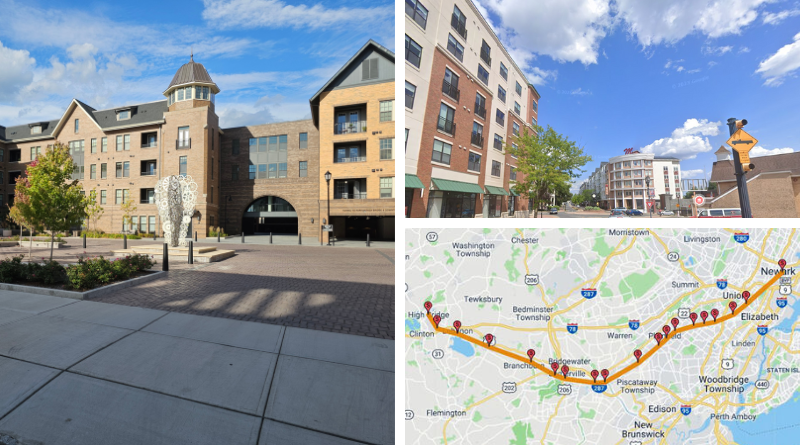Somerville Station in Somerville, NJ (left); Meridia Main Station in Bound Brook, NJ (top right); and station locations on the NJ TRANSIT Raritan Valley Line (bottom right)
With direct connections to Newark and, via a transfer, New York City, NJ TRANSIT’s Raritan Valley Line has long been a vital corridor for the communities of central New Jersey. Six towns along the line— going east to west: Cranford (2003), Plainfield (2014), Dunellen (2013), Bound Brook (2003), Somerville (2010), and High Bridge (2025)—have earned designation as Transit Villages through the New Jersey Department of Transportation’s Transit Village Initiative. These communities are leveraging their transit access to support downtown revitalization, attract development, and meet growing housing needs.
The Raritan Valley Line connects to Newark Penn Station, with continuing service to New York Penn Station. A typical peak-hour trip from Raritan Station to New York takes about 90 minutes. In 2014, NJ TRANSIT introduced limited off-peak one-seat rides, eliminating the transfer at Newark and saving 10-20 minutes.
Proximity to the Raritan Valley Line remains a strong draw for those commuting to major employment centers. But with New Jersey continuing to lead the nation in remote work per capita, strategies focused solely on the commuter market may fall short. Municipalities must also highlight the commercial, recreational, and quality-of-life benefits of accessible transit.
By positioning themselves as destinations—not just residential hubs—these towns can attract new residents, businesses, and visitors. Transit Village designation and proximity to the Raritan Valley Line provide a platform for economic growth and downtown revitalization.
Recent changes to New Jersey’s affordable housing laws have added further momentum. Under the recently updated New Jersey Department of Community Affairs (DCA) rules, development near transit can help municipalities meet their housing obligations, potentially mitigating concerns about increased density, such as traffic congestion. The law also includes a valuable incentive: affordable housing built within a half-mile radius of a transit station earns bonus credits. For example, 100 units of affordable housing built near transit count as 150 units toward a municipality’s obligation.
Cranford, Plainfield, Dunellen, Bound Brook, and Somerville highlight how communities can harness these advantages to shape growth, meet housing needs, and strengthen local economies. In 2025, the Raritan Valley Line welcomed a sixth Transit Village: High Bridge, located at the western terminus of the line.
The New Jersey Transit Village Initiative
Launched in 1999 by NJ TRANSIT, NJDOT, and other state agencies, the Transit Village Initiative designates municipalities committed to revitalizing areas around transit hubs as “Transit Villages.” This designation provides benefits such as priority funding, technical assistance from state agencies, grant eligibility, and a strong State commitment to support the municipality’s redevelopment vision.
Celebrating its 25th anniversary in 2024, the initiative now includes 37 designated Transit Villages across New Jersey, served by light rail, commuter rail, and high-frequency bus service. As the state faces challenges like housing affordability, climate change, and traffic congestion, leveraging transit stations for sustainable, mixed-income development has become increasingly important. Transit Villages exemplify the advantages of compact, mixed-use, transit friendly development and demonstrate the value that well-designed transit facilities can bring to communities.
Each Transit Village along the Raritan Valley Line has pursued its own path to revitalization, shaped by local assets, challenges, and priorities. What they share is a commitment to leveraging their transit access to strengthen their downtowns, expand housing options, and enhance quality of life. The following sections highlight how these communities—beginning with Somerville—have made transit-oriented development a key part of their long-term strategies.
Somerville
At the start of the 2000s, Somerville faced significant challenges. Shoppers had shifted to the nearby Bridgewater Commons Mall, contributing to a steep economic decline in the Borough’s downtown. The area surrounding Somerville Station was dotted with vacant lots and dominated by a former landfill. To reverse the trend, the Borough launched an extensive community engagement process that led to the 2007 Somerville Station Area and Landfill Vision Plan. Developed with partners such as NJ TRANSIT, the Regional Plan Association, and Somerset County, the plan envisioned Somerville as a vibrant, transit-oriented community with a mix of residential, retail, and public spaces designed to foster interaction, diversity, and affordability.
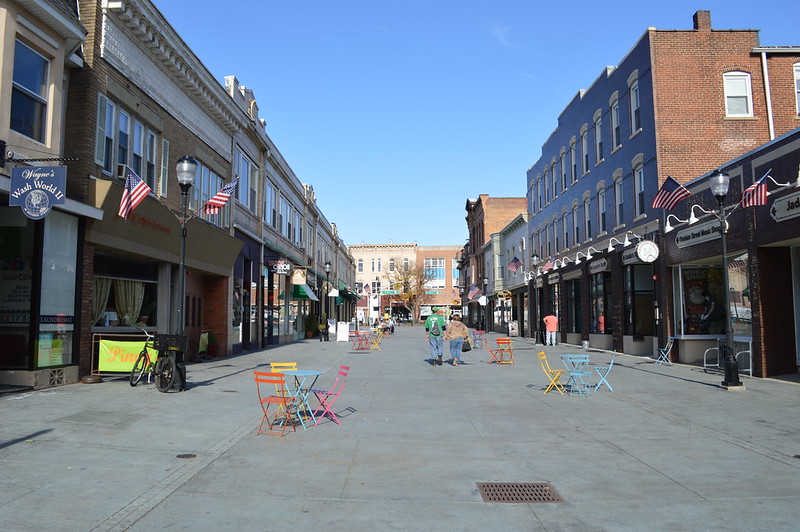
The Borough’s strategy earned Somerville its Transit Village designation in 2010. As part of the Initiative, it received a $100,000 grant to widen Division Street’s sidewalks near the station. During construction, the Borough restricted access to pedestrians and cyclists only—a change embraced by the community. Within 18 months, Division Street went from half-empty to fully leased, emerging as a vibrant pedestrian street revitalization.
By 2014, Somerville’s vision began to take shape. The Edge at Main, a mixed-use development with 108 homes and retail including ShopRite, Starbucks, and Wolfgang’s Steakhouse, opened just a five-minute walk from the station. Several other developments soon followed. The Cobalt Apartments, a 117-unit complex built on a former junkyard near the station, opened in 2018. That same year, The Davenport, a 60-unit project at 21 Davenport Street, was completed just off West Main Street.
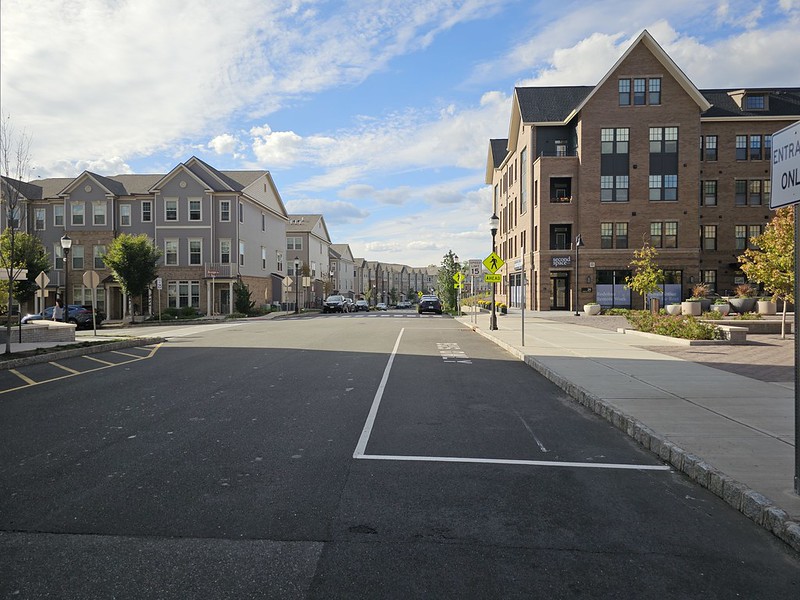
Across from the station, redevelopment of the former landfill site took more time. In 2021, PulteGroup completed a 156-unit townhome community on the site. In 2023, AvalonBay opened a 374-unit apartment complex with street-level retail, a public plaza, and a civic center. AvalonBay also gained preliminary site plan approval for a 171-unit building near the train station in April 2025. Both developments sit adjacent to the station and within walking distance of downtown. And in 2024, developer Edgewood Properties added 153 more residential units and additional retail to The Edge at Main.
In addition to housing, Somerville has made cultural and aesthetic investments. Public art—including murals honoring Lee Van Cleef and Raymond Brown, as well as the Cre8 Bench Project—has added visual appeal. New restaurants and shops have energized the area, including Turf, Surf & Earth; Kyma; Seoulville; Village Brewing Company; Elysium Antiques; Osprey Lane Boutique; and The Hungry Hound.
Somerville’s revitalization has also driven population growth. Since 2020, the Borough’s population has risen 14.3 percent—from 12,346 to 14,112—surpassing its 1970 peak.
Somerville’s success story demonstrates the long-term payoff of coordinated planning, community engagement, and a willingness to invest in underutilized assets like a transit hub.
Bound Brook
In 2003, Bound Brook became the first municipality along the Raritan Valley Line to be designated a Transit Village. Like Somerville, Bound Brook faced significant challenges but saw an opportunity to turn those challenges into a foundation for long-term revitalization.

Located on a low-lying flood plain, Bound Brook struggled for decades with recurring flooding. That changed with the completion of the $430 million Green Brook Flood Control project. The massive undertaking included levees, flood walls, detention reservoirs, and pumping stations, which dramatically reduced the threat of flooding and opened the door to downtown redevelopment.
In 2010, Bound Brook partnered with the Regional Plan Association to create a Downtown Urban Design Plan focused on compact, pedestrian-oriented, mixed-use developments near Bound Brook Station. To put the plan into action, the Borough adopted zoning changes that expanded its residential/business mixed-use district, raised density thresholds, and established tax incentives for new development—some supported through a federal Opportunity Zone grant.
Complementing these land-use and policy changes, Bound Brook made a series of infrastructure and placemaking improvements. Using Transit Village Initiative grant funds, the Borough enhanced pedestrian and bicyclist infrastructure around the station. In 2014, Bound Brook opened a new public recreational building downtown, featuring a gym, locker rooms, and meeting spaces. Around the same time, the Borough also upgraded facilities at Billian Legion Park, also located downtown.
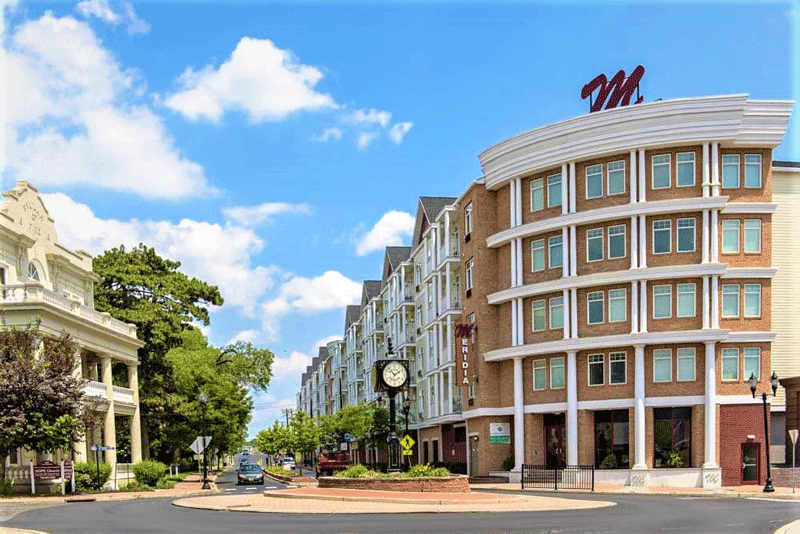
Bound Brook’s first major transit-area development arrived that same year: Meridia Main Station, a 240-unit apartment complex located on the east side of Main Street. Developed by Meridia, the project marked the start of a surge in downtown construction.
Between 2015 and 2022, Bound Brook added 500 new one- and two-bedroom apartments with new development continuing at a steady pace. In 2023, Accurate completed Citizen Bound Brook, a 105-unit apartment building. Later that year, Denholtz Properties broke ground on The Rail at Bound Brook, a 143-unit, six-story development adjacent to the station. The project opened for lease in June 2025. Soon after, the Borough approved three more Meridia projects along Main Street, totaling 286 residential units and additional retail space.
By combining strategic planning, infrastructure investment, and federal tax incentives, Bound Brook has positioned its train station as the anchor of downtown renewal. Over the past decade, the Borough has seen the construction of more than 750 multifamily housing units, with hundreds more in the pipeline. The population has grown from 10,402 in 2010 to 12,371 in 2023, and Borough officials estimate it could reach 14,000 in the near future.
Dunellen
Dunellen, a borough that grew around its historic rail station, was designated a Transit Village in 2013. This designation supports the Borough’s ongoing work to implement transit-oriented development (TOD) goals outlined in its 2003 Downtown Redevelopment Plan. The plan’s first phase prioritized properties near Dunellen Station, calling for mixed-use commercial and residential development, new municipal and civic buildings, and reuse of a vacant 19-acre warehouse site adjacent to the station.
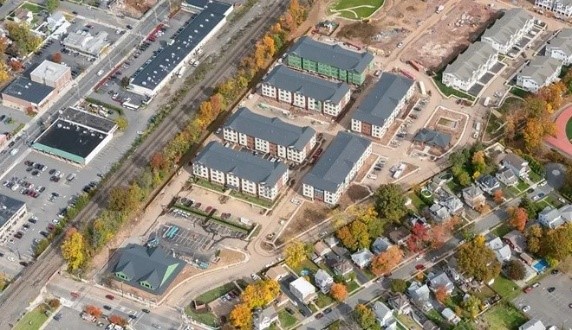
In 2022, The Nell at Dunellen Station opened for residential and commercial lease. Developed through a partnership between the Borough of Dunellen and private entities, the long-planned project transformed a brownfield site into a mixed-use complex with 200 market-rate apartments, 58 low- and moderate-income units, 130 townhomes, and retail space. Located next to Dunellen Station, the development offers direct access to transit and downtown. In 2024, the project received a New Jersey Future Smart Growth Award.
As The Nell neared completion, the Borough established a five-year tax abatement program to encourage additional downtown reinvestment. The program applies to upgrades made by existing property owners, new construction, and conversions of existing buildings within the redevelopment area surrounding the station. While many municipalities rely on 30-year Payment in Lieu of Taxes (PILOT) agreements to support large developments like the Nell, Dunellen’s shorter program gives smaller developers and property owners access to similar benefits.
“These projects, after being built, generate more revenue even with a tax incentive than they would have ever provided if the property remained the same,” said Mayor Jason Cilento, who has served since 2020.
In 2024, Dunellen expanded its revitalization efforts by formalizing the Dunellen Downtown Management Organization (DDMO) as a government entity and broadening its scope. Created during the Transit Village designation process, the DDMO brings together residents, business owners, municipal officials, and non-profits to support downtown development through business promotion, beautification, and events.
Working with Creative Strategies, the Borough has also begun exploring a Special Improvement District, engaging with local stakeholders to identify opportunities. Borough leaders see commercial development as a way to offset the tax burden on property owners, though officials recognize that community buy-in is essential. So far, the response from business owners has been mixed.
Construction continues to reshape the area around the station. Current projects include a 33-unit mixed-use development with 2,000 sq. ft. of retail space, a 47-unit mixed-use project, and two adjacent mixed-use projects by Taylor Architecture & Design that will add 100 homes. Since 2020, Dunellen has attracted nearly $175 million in new development and improvements. These efforts have drawn recognition, including a 2024 Smart Growth Award, a feature in Business View Magazine, and designation as a “Great Downtown” by APA-NJ.
“The goal is to make sure that downtown TOD drives economic growth while adding the amenities and services that make Dunellen a destination in its own right — a place where people say, ‘Let’s go to Downtown Dunellen tonight,’ instead of heading to other towns,” Cilento said.
Plainfield
Plainfield, the largest Transit Village along the Raritan Valley Line, contains two NJ TRANSIT stations—Plainfield Station, the focal point of the Transit Village, and Netherwood Station—and offers substantial bus service. Leveraging these transit assets, the City established Transit-Oriented Development (TOD) Zones around both stations, aiming to encourage dense, mixed-use projects within a quarter-mile radius. These steps contributed to Plainfield’s designation as a Transit Village in 2014.
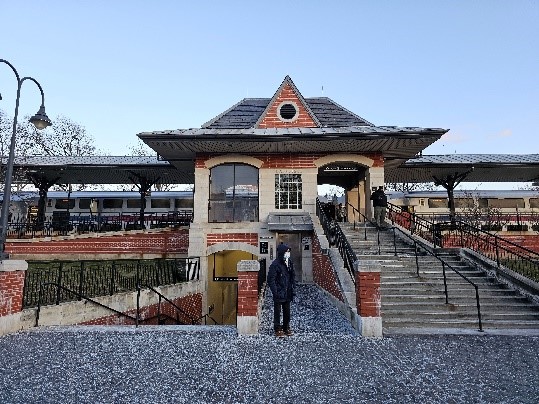
Before receiving Transit Village status, Plainfield saw limited growth, with its population increasing by only 4,500 residents between 1960 and 2010. Since 2010, however, Plainfield’s population has grown by nearly 5,000 people. The City achieved this by identifying and redeveloping underutilized properties, particularly near the train stations. Alongside zoning changes and planning efforts, Plainfield launched a marketing campaign targeting investors, highlighting assets such as its cultural diversity, historic districts, local business incentives, and transit accessibility.
Over the past decade, Plainfield secured significant investment in residential development. In 2019, QUIN Sleepy Hollow by JMF Properties—a mixed-use, mixed-income development comprising 212 homes and retail space—opened near Netherwood Station. Since 2022, the area has added 1000 North Ave, a 120-unit apartment building developed by Iron Ore Properties, and Netherwoods Flats, a 70-unit mixed-use development by Paramount Assets.
In 2021, The Station at Grant Avenue, a fully affordable 90-unit development, opened within walking distance of Plainfield Station. In 2023, the first phase of Citivillage at Plainfield Station—a 131-unit apartment building—was completed as part of a larger project that will ultimately deliver 1,400 homes. Upcoming plans include Phases 2-4 of the Citivillage at Plainfield Station project, the 357-unit luxury housing project BELLA, and a 71-unit apartment building at 110-120 West 6th Street. Most recently, in July 2025, Centurion Sleepy Hollow, a 100-unit building near Netherwood Station, opened for leasing.
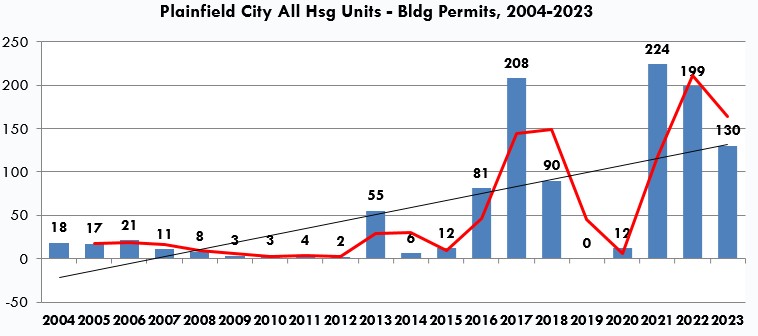
In November 2024, Plainfield earned Main Street New Jersey (MSNJ) designation, a program that promotes downtown revitalization by providing grant opportunities for infrastructure improvement projects, operational support, and the implementation of innovative strategies. Together, Transit Village and MSNJ designations provide Plainfield with multiple avenues of state support to make its downtown an attractive location for new development and growth.
Cranford
Cranford’s proximity to Newark and New York City makes it a prime location for transit-oriented development. As the Transit Village closest to these major cities along the Raritan Valley Line, it has the highest percentage of workers commuting by public transportation. These factors have made TOD central to Cranford’s planning policies. In 2005, redevelopment efforts driven by the Township’s Office of Business and Economic Development earned an NJ Future Smart Growth Award for fostering a walkable, transit-friendly, and historic downtown.
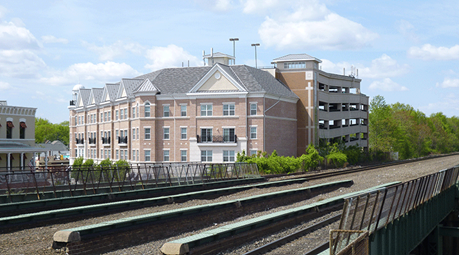
Cranford’s early 2000s planning decisions laid the foundation for a series of downtown development projects. In 2006, Westminster Communities opened Cranford Crossing, offering 50 rental apartments and 22,000 square feet of retail space near the rail line. In 2013, the Riverfront at Cranford Station was completed, adding 127 rental units, 20,000 square feet of retail space, and 20,000 square feet of office space to the downtown. That momentum continued with Woodmont Station at Cranford, which opened in 2015 with 163 homes, including affordable housing. Located three-quarters of a mile from Cranford Station, the development addressed the “last mile” challenge by offering a shuttle service to the station during peak hours. In 2019, Iron Ore Properties completed The Albero, a mixed-use project with 24 homes and three ground-floor restaurants just a block from the station.
Today, Cranford has several new projects underway or recently completed. Iron Ore is building a new development with 94 rental homes and additional retail space within walking distance of the station. In March 2025, Hartz Mountain Industries opened Fairways at Cranford, a 250-home complex located 1.3 miles from Cranford Station—highlighting the need for a strategy to better connect residents to public transit and the Borough’s core. And in summer 2025, the 59-unit apartment building at 201 Walnut Avenue opened just steps away from the station, bringing new residents to the downtown.
DCA has determined that Cranford must provide 204 affordable homes to meet its current obligation and another 268 to meet future needs under the fourth round of affordable housing requirements. While Fairways at Cranford will contribute toward this goal, the Township will need to plan for additional development. In June 2025, Cranford adopted its Fair Share Housing Plan, focusing on senior housing, qualified group homes, and transit-oriented projects as part of its strategy.
High Bridge
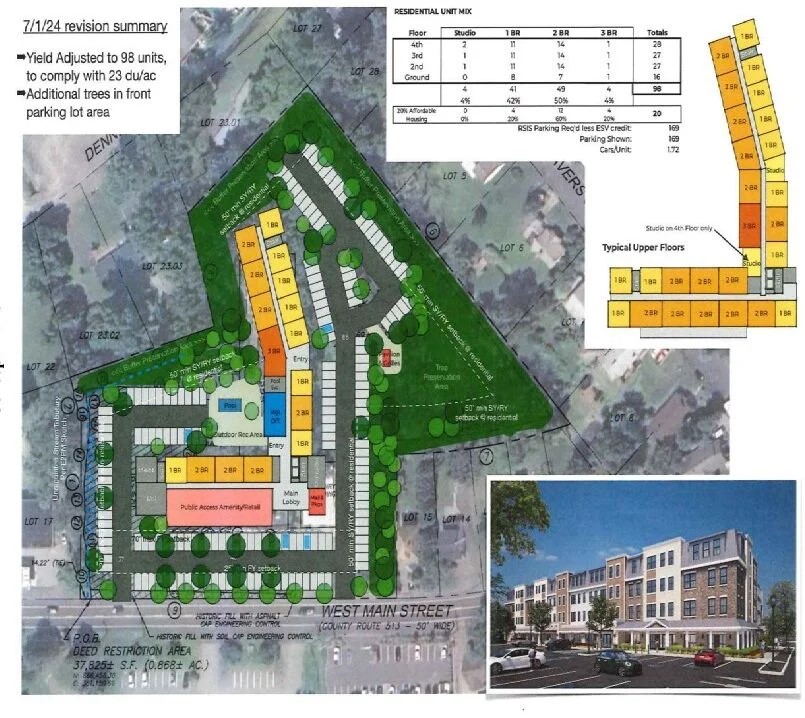
High Bridge became New Jersey’s 36th Transit Village in February 2025—the sixth along the Raritan Valley Line, and the first in Hunterdon County. The Borough joined the initiative to spur economic activity downtown by fostering a more vibrant, walkable, and transit-friendly environment near High Bridge Station. Although current rail service is limited—seven weekday trains and no weekend service—High Bridge plans to leverage its station to attract downtown mixed-use development. In December 2024, the Borough approved a 25-unit, mixed-use development next to the station, and in January 2025, it approved a 98-unit, mixed-use development just 0.4 miles away.
Building on a Transit-Oriented Foundation
The communities along the Raritan Valley Line show how sustained investment near transit can shape long-term growth. From smaller towns like Dunellen and Bound Brook to larger municipalities such as Plainfield and Cranford, these Transit Villages have advanced redevelopment goals, expanded housing options, and helped reinvigorate downtown districts. In each case, access to rail service played a central role as a catalyst for local planning and public-private collaboration.
While each community followed its own timeline, common themes emerge: aligning redevelopment with existing transit, addressing affordability, and adapting strategies to changing market conditions. These local efforts reflect a broader shift in New Jersey’s development priorities—one that values walkability, access to opportunity, and more sustainable land use.
NJ TRANSIT has played a key role in supporting this progress. Through the Transit Village Initiative, the agency provides technical assistance, funding, and policy support that help municipalities advance transit-oriented development that aligns with local goals.
As High Bridge joins the Transit Village Initiative, it enters a corridor shaped by over two decades of transit-oriented planning. The experience of its neighbors offers a reminder that successful TOD requires local leadership, long-term vision, and continued coordination among municipal, regional, and state partners.
Resources
Bound Brook Apartment Boom Continues With Another Major Project Approval | MyCentralJersey
Construction Underway for 357 Luxury Apartments in Plainfield | Real Estate NJ
Decades-Long Quest to Redevelop Somerville Landfill Enters Final Chapter | MyCentralJersey
Dunellen, New Jersey’s 26th Transit Village | NJTOD
First Renters Arrive at New Luxury Apartment Building in Bound Brook | Real Estate NJ
Groundbreaking Set for 143-Unit The Rail at Bound Brook | Jersey Digs
High Bridge Names West Main Street Re-developer; Honors Heroes | Hunterdon Review
How Transit Villages Are Reshaping New Jersey’s Urban Landscape | Planetizen
Iron Ore Starts Construction After Inking Loan for New 39-Unit Rental Project in Cranford | Real Estate NJ
Iron Ore, AMJ Unveil 120-Unit Luxury Rental Project at Plainfield’s Netherwood Station | Real Estate NJ
Learning to Love Growth | City Journal
Municipal Spotlight: TOD in Cranford Township | NJTOD
New Project Bolsters Cranford’s TOD Mission | NJTOD
Newest Apartment Building in Plainfield Sets Grand Opening | MyCentralJersey
NJ Has Named Its First Hunterdon County ‘Transit Village’ | MyCentralJersey
Plainfield Selected to Main Street New Jersey Program | MyCentralJersey
Plainfield TOD Open for Business | NJTOD
Plainfield, NJ.: A Diverse City With Historic Housing | The New York Times
Planning & Engagement Advance Somerville’s Goals | NJTOD
Prism’s Nell named New Jersey Future 2024 Smart Growth Award Honoree | ROI NJ
Redevelopment Creates a Neighborhood in Downtown Cranford | NJ.com
Redevelopment Plans Lead to Results in Bound Brook | NJTOD
Small Town, Big Plans: New Development Helping to Spark Revival of Downtown Dunellen, as Borough Eyes Additional Projects After Years of Planning | Real Estate NJ
Somerville, NJ.: A Walkable Suburban Alternative | The New York Times
The 4th Round of New Jersey Obligations: A Transit Friendly Perspective | NJTOD

